With funding-related legislation a non-starter in Salem this coming session, the City of Porltand Bureau of Transportation (PBOT) instead sees an opportunity to work toward major, statewide policy changes that would support its transportation goals.
High atop their list of priorities for the 2011 legislative agenda is a much-anticipated strategy to wrest authority of setting speed limits away from the Oregon Department of Transportation (ODOT) and give it to local jurisdictions. Currently, ODOT sets speed limits, even on streets owned and managed by cities and/or counties.
Shoshanah Oppenheim, who works on streetcar project management for PBOT, is working on the bureau’s legislative strategy. At this month’s Bicycle Advisory Committee meeting, she said, “This session is going to be very challenging for any funding opportunities… We’re being realistic that making a run for money shouldn’t be our number one goal.”
“A long-term strategy to improve the safety of our streets and to promote cycling and part of that includes more control… of defining speed limits…”
— Shoshanah Oppenheim, PBOT
Oppenheim says their legislative package will focus on three main areas; preservation and maintenance of our current roads by going after larger pieces of existing revenue streams and creating new ones (through new fees or fines), improving the safety of the system for all users, and reducing impacts on climate change from the transportation sector.
A key part of Adams’ efforts for a safer transportation system is the ability to reduce speeds on neighborhood streets. Slower speeds are absolutely critical to saving lives and creating a comfortable biking environment and Adams has been working on this issue with ODOT for over a year now. With the City about to announce ribbon-cuttings on a host of new bike boulevards (a.k.a. “neighborhood greenways”), Adams has the added, on-the-ground impetus to move on this issue.
In a conversation today, Oppenheim said PBOT has, “A long-term strategy to improve the safety of our streets and to promote cycling and part of that includes more control to the jurisdictions of defining speed limits in certain situations and we’re working with ODOT to develop a strategy of what that would be.”
Speed limit authority might not be the only thing PBOT looks to change in Salem. At the Bike Advisory Committee meeting earlier this month, Oppenheim refferred to the “antiquated nature of our motor vehicle code” and said that any opportunities to review the current code so “We have better tools for a safe bicycling environment” would be explored.
Oppenheim also made it clear that PBOT would be looking for setting speed limits only in specific, defined circumstances. Instead of a blanket revision to speed limit-setting authority — which ODOT is unlikely to simply give up easily — it’s more likely that PBOT would look to create a new legal designation for bike boulevards. Then, once bike boulevards are defined in the Oregon Revised Statutes, they could lobby for the legal authority to lower speed limits on such streets.
Currently, PBOT is able to change speed limits, but only after going through a request process with ODOT. Learn more about how ODOT sets speed limits in this BikePortland article from November 2009: Speed limits and ODOT: A primer.
To learn more about the City’s 2011 legislative agenda, come to a Community Town Hall on August 2nd at City Hall.

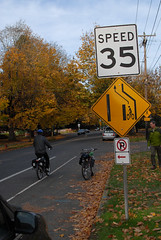
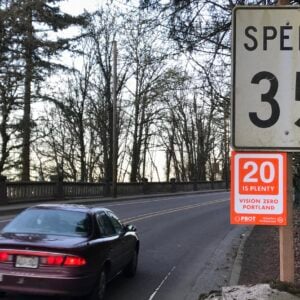
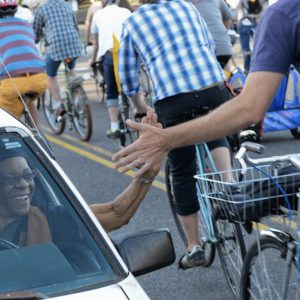
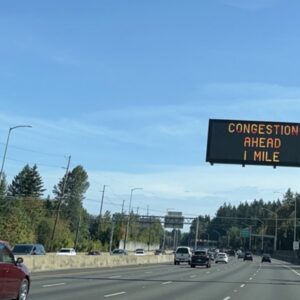
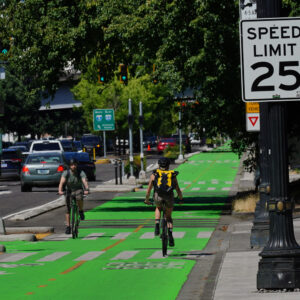
Thanks for reading.
BikePortland has served this community with independent community journalism since 2005. We rely on subscriptions from readers like you to survive. Your financial support is vital in keeping this valuable resource alive and well.
Please subscribe today to strengthen and expand our work.
What does it matter if you can set speed limits on residential streets if you don’t enforce the speed limits that already exist?
Has anyone ever seen the PPB set speed traps for motorists on residential streets?
I have not.
What I see on the residential streets around my SE PDX house — which is in a school zone and has speed bumps — is many people driving way faster than 25. And the few PPB patrol cars that do pass by never seem to care about the speed of those vehicles.
Seems like the PPB has other priorities…
@Velophile, I’m in total agreement with you. My house is located along N. Williams Ave, which in years past has hardly been seen as residential, but within recent years has become even more so with all the development going on. I hope that PBOT will take into consideration slowing down traffic on the strip with the increase of traffic and now, bike congestion. With no speed bumps on the stretch, currently I see people in excess of 40 mph speeding through. I also don’t see the street being enforced at the current speed limit of 30 mph.
I am thrilled to hear this. One of the main limiting factors that make a road feel safe is the speed of traffic and the absurdity that Portland can’t control it’s own speed limits should be eliminated.
I also think Velophile makes an important point that speed limits (like the cell-phone ban) are only going to be worth the enforcement applied to that law.
How can we as a community help PBOT in succeeding with this?
Speed ‘limits’ are often largely ignored or pushed, especially by more aggressive and/or impatient road users. How about something more worthwhile? *coughIdahostoplawcough* no incedents in the state i grew up in since 1982 can’t be wrong.
I don’t know if any of you know this, but law-enforcement officers are sometimes corrupt. Corrupt law enforcement like to do things like set up speed-traps. Not the 21st, Hollywood version of such, but an actual speed-trap. Like setting speed-limit signs really close together so when you drive by, you’re almost surely going to be speeding. Then, you work out a deal with the local district judge, and take a piece of the rake for your bass-boat.
Or, how about deliberately placing speed-limit signs on hill-crests, and around corners, so that you can’t see them?
Point is, it’s not some sinister conspiracy, or some power-grab that has things the way they are here. Giving a State entity control over such things was a move to protect Oregon citizens from corrupt law enforcement.
I’m not even saying this is a good, or bad thing, I’m simply trying to be a voice of reason.
K, so let’s say you get your way, and reduce all speed limits to 1? Fine, the law of the land, and all… But, what is the plan to keep local law-enforcement authorities from abusing that authority? I mean, you all are smart people, did any of you consider this?
I’m much more comfortable with an unwieldy bureaucracy than I am gun-toting Extreme Sports fanatics. Really, I am.
i wonder if the new burnside west will be under 35. I think MLK/Grand and Eastside Burn are way too fast. I am sure there are DOZENS or other examples.
N willamette between Rosa parks and st johns needs to be lowered to closer to 25-30, 35 is way to fast for that narrow, windy, busy road.
Ha ha, wait til Holgate gets a 5 mph limitz…
For once I’m in (general) agreement with Vance. I think if anybody actually did any research into why the state has control of speed limits, it would probably be the case that it was a legislative response to small-town abuses of the law through the employment of speed traps.
I don’t agree that the problem being addressed by the current law is “corrupt” law enforcement officers, so much as it is corrupt small towns, which have historically relied on raising revenue by trapping unsuspecting travelers into technical violations of the law, rather than by raising revenue through more honest means (by taxing their own residents, for instance).
There are often unintended consequences to well-meaning initiatives, and Vance is right on this one. That doesn’t mean that we shouldn’t try to figure out how to lower speed limits where we need to, but we shouldn’t do it through means that enable corrupt abuses of the law.
In real world driving speed limits are irrelevant. Drivers drive the speed they feel comfortable on a certain road, and in general the majority of drivers will drive the same speed. You can lower limits all you want, but traffic is still going to go the same speed. Adding speed bumps to a major artery like Williams is crazy. Enforcing speed limits is the ONLY thing that slows people down. Without enforcement all other points are moot.
the hidden speed trap problem, to the extent it exists, tends not to be a problem on the urban grid. has more to do with dropping the limit suddenly from fifty-five on the two-lane country highway. and if you saw the signs saying “podunk five miles” you might have been able to anticipate a drop in the limit. maybe PBoT could frame its legislative agenda in terms of allowing larger cities to set their own speed limits. not too many hidden curves and crests around here that don’t already have the advisory fifteen or ten on them.
Short term fix – identify all the home-school families and set up 20MPH school zones all over town.
rixtr – Precisely man, thanks for cleaning up my mess. Argh. Anybody wanna spring for my Writing 101 class? But you’re so right. This isn’t ancient history either. For Pete’s sake, try to escape McMinnville without a moving violation. Today!
I’m thinking it’s more prudent to streamline the bureaucratic process than it is to let these small town municipalities off their leash. Plus, where we’re a tourist destination, oh boy are tourists ripe for the picking.
It’s probably too cynical for this crowd, to accept our position, but ding-dang, look out you all don’t wind the clock back too far.
Allowing municipalities to determine speed limits on certain streets could help them to create streets that were safer for everyone to use, and also, enhance the livability of areas through which so designated streets passed through.
“…speed limits (like the cell-phone ban) are only going to be worth the enforcement applied to that law.
How can we as a community help PBOT in succeeding with this?” Aaron #3
Help PBOT and the PPD by you and your neighbors going to your neighborhood association meeting to report your observation of unchecked excessive speeding in your neighborhood and through school zones. Power in numbers; other neighbors present that feel similarly to yourselves could result in a message from the neighborhood association sent along that may get more attention and action than just one or two residents making a call.
I have spent the last 6 weeks plus on crutches so my enjoyable bicycle commute has morphed into a dreaded car trip. I have noticed numerous issues during this time but one more than most. Most non-auto users of the roads and walks are often in peril primarily due to haste, distraction, their own behaviors or congestion. It is fairly rare for cars to stop at even marked cross walks let alone peds standing at a corner (that’s the law, by the way). Calls for enforcement, while obviously needed don’t really reflect reality. Who will do this enforcement? I keep thinking over and over that if a car trip was undertaken from a strictly legal perspective: driving with care and at a legal speed, slowing down for yellow lights, stopping fully at white lines; a bicycle would be an obvious choice for more of us. The difficult dilemma is how to do this enforcement.
They never enforce the 25 mph speed limit on SE Hawthorne, SE Division or other lower-level inner SE arterials like 26th, 28th or Clinton, either.
I think what the city is hoping for is the ability to do things like make all the bike boulevards either 15 or 20mph which would serve as one more added incentive for people driving cars to pick a different road.
How about a streamlined speed reduction test plan?
Have ODOT give preliminary approval for all speed reductions if there exists data for 5-10 years showing conditions that might be improved by speed reduction in an area.
Reduce the speed in the area requiring that there are warning signs, standard yellow or perhaps fluorescent yellow-green, of the speed in place before implementation.
After 1-2 years analyze data against prior year stats: if an improvement has occurred ODOT should finalize and make permanent the change in that area.
Speed limits are a poor substitute for good street design. Drivers go a speed they are comfortable with on that stretch of road. It might even be a “safe” speed, if nothing unusual happens on the road (ie livestock on the road). If you want drivers to go slower, you need to change the road.
Speed limits are good for revenue though. The main example was New Rome, Ohio, a corrupt town that funded itself through a speedtrap. Its mostly a problem with small town that have a rural highway, but it could be employed in a city too. Drop Naito or Powell down to 25 for a block or two.
are #11 – I wonder if you are familiar enough with our localized commute patterns to hold up such an assertion? The scenario myself and rixtr are speaking to will come into play driving to Sherwood, Newberg, Wilsonville, Corbett, Washougal(kinda), Camus(kinda), Oregon City, and most especially the longer commutes like Dundee, Dayton, Mac, and Corvalis.
I totally agree that it would be hard to play games from within the heart of a modern urban metropolis. But there are a TON of commuters here that travel the routes I just described, and I guarantee you I just listed some seriously accurate locations for just the kind of hijinx I’m talking about. Please try to understand that outsiders don’t really enjoy a welcome here. If you think it’s bad here, go just a few miles out of town, where Portland is sort of starting to encroach, and the anti-outsider sentiment borders on hysteria. Local law-enforcement will victimize you at the drop of a hat for just being a Portlander passing through. Profit motive be damned at that point. They’ll do ya just for the sake of it.
Never forget that John Birch headquartered here. Or that we JUST, and I mean JUST, got rid of a large-scale white-supremest problem right here in town. NW Knob Hill, to be precise. As you more urbane, city-liberal types proliferate it’s easy to forget your smack dab in the middle of some of the last real estate to get domesticated in the American west.
I think certain parts of N. Williams Ave could use speed bumps, the stretch becomes much more residential from Skidmore to Killingsworth. This can’t be any more far fetched than N. Vancouver which benefits from both speed bumps and a single car traffic lane. The point is to make N. Williams more of a bike centric corridor than an arterial for cars. Slow down traffic in general. I-5 and MLK should be the main arterials in the area. Certainly I’m biased since I live on N. Williams…
Absent enforcement, which is too often absent, will a reduction of speed on residential streets then make those streets eligible for more advanced traffic-calming devices like entry treatments across intersections, channelization changes, modified intersection design, traffic diversions, surface texture and visual devices, woonerfs or even street closures?
Most residential road users would like a safer, calmer more Mayberry-like street but have no idea if it is even possible any more or how to go about making those changes.
While this points to the need for education it also points to the need for small local Proof of Concept test area that show that these things do in fact work. Then we can begin the process of re-branding these European ideas as American and actually implementing them.
Portland should work to institute a city-wide 25 mph speed limit (except on a few well defined “designated auto routes”). That would be awesome.
A blanket revision is exactly what we need. Consider aiming higher.
I highly doubt Portland would realistically seek, let alone get, a blanket exemption from uniform state traffic laws.
I do think setting lower limits on bike boulevards is a good idea, so that we can design the streets for good bicycle flow without also encouraging drivers to use them.
But I also agree the city could do better with the legal tools it already has, especially enforcement. Just try driving down NE Broadway at the 20 mph speed limit. EVERYONE will go blasting around you. No one even seems to KNOW that the speed limit is 20. Regular speed enforcement would fix that problem pronto.
And for that matter, why is Hawthorne from 30th to 39th NOT designated 20mph? 25 is WAY too fast in this stretch of high pedestrian density and 9′ traffic lanes. The city could make this change within existing state law simply by declaring it to be the business district that it is. And there are many other cases like this. Unfortunately the city often lacks the will to do these things because many people complain about reduced speed limits.
And ultimately citizens’ attitudes are where change will need to happen. Help make it NOT okay to speed. Although speeding gives the driver an ego trip, on the city grid it doesn’t actually save very much time at all.
Besides endangering pedestrians, kids and cyclists, speeding also wastes fuel. Maybe we could make some headway on the problem if we raised awareness of it as an environmental issue! I’m always amazed that in allegedly “green” Portland, there’s practically zero awareness of how irresponsible driver BEHAVIOR wastes energy and warms the planet. We can cram our streets with hybrids, promote cycling, buy carbon-free electricity and mandate biofuel content, but we can’t get people to stick to the speed limit?
To borrow from baseball, PBOT needs to start manufacturing runs rather than relying on the long ball. This smacks of swinging at any pitch near the strike zone to get a quick political victory. As others have stated, designate a few test areas around town, gather good data, and then ask for this speed limiting power once you prove your concept.
In light of the Holgate fiasco, I think Portlanders might be a bit reluctant to give such sweeping and potentially arbitrary power to PBOT.
as nice as it would be to give the city more power to control itself this could be dangerous to smaller cities with not so good intentions…
you all mention speed traps but when reading this article I thought of bicycle bans… smalls anti-bicycle towns can increase their speed limits and create an unsafe feeling for bicycles which will lead to less bicycling…
BURR #16 you mention enforcing the 25 mph speed limit on Hawthorne, Division, Clinton, and 26th… however I am around those areas often and I rarely see speeding… those are narrow streets (west of 60th) and that itself causes traffic to go slow… sometimes on the Hawthorne 4-lane it can be a little fast, but it’s not a good street for bikes…
Speed traps work by forcing drivers to pay attention, particularly in small town areas. If you have ever lived in a small town with a rural highway through it and have watched ‘city drivers’ race through the place you live, bike, walk etc. you might be more disposed to consider a speed trap as a quality/safety of life issue.The whole idea that drivers are being somehow tricked into tickets they don’t deserve because of a nefarious scheme to cheat them is just not an accurate portrayal. I have never seen one example of an area where my driving speed couldn’t be reasonably adjusted to meet the limit providing I am a) already within the posted limit and b) paying close attention. I think it’s good that law enforcement has a monetary incentive to ticket speeders for everyone’s sake. Is it really duplicitous to enforce posted speed limits where they occur? The places where speed zones change are (not coincidentally) the most important places to target- again, when a highway runs through a small country town or rural intersect doesn’t it make sense to make the change more abrupt.
I’ve posted some of my own dilemma before on this site, but out here in Washington County I wish they would consider the same idea. We’ve been working with Wa.Co. DOT on a crosswalk or crossing signal for the elementary school that I teach at, which is just east of PCC-Rock Creek. They did a traffic survey back in late September, and even Commissioner Schouten came to one of our Walk to School Day events this past Spring. The traffic study said that the current speed limit on NW Springville Rd will not be reduced from 45 mph to even 40 mph because, ” A reduction in speed limit is actually more dangerous because of the current driving habits that people have.” We’re basically waiting for a bad injury or a fatality to happen between a biker/walker and a car before anything will get done. Wa. Co even cited the number of accidents and incidents that HAVE to happen before a change takes place. Crazy!! Wa. Co also explained that a school crosswalk, or school zone would never be installed in a 45 mph zone, but they can do it less than 2 miles away in a 40mph zone??
I highlighted a previous article from this site about how much safer a street is even by reducing the speed limit by 1-2 mph, and I got no response from Washington County. We are hoping that the planned North Bethany improvements will do something to support walking and biking to school in this area.
It’s an uphill battle, but I’ll continue to be an advocate for my students, and certainly ( somewhat selfishly) my own bicycle commuting wishes.
The only time traffic on lower SE Hawthorne or Division is obeying the 25 MPH speed limit is when they are forced to by congestion. Most of the time traffic moves at 30 to 40 mph on both of these streets.
And even if you don’t think Hawthorne and Division are good streets to cycle on (and I beg to differ with your opinion on this), it’s nearly impossible to avoid crossing these streets if you’re traveling north-south or avoid getting on these streets for short distances even if it’s just to access the bridge.
Psyfalcon 19
I agree, design largely dictates behavior. Building a huge road, then having to come back and install signs, bumps,bio-swales, curb extensions, stripes and green paint all over it to get users to use it “correctly” is not just inefficient, it’s mindless, and the law.
25mph is slow enough.
If anyone is willing to sit in a car you can ride shotgun with me and I will show you how slow cars are really going.
Even setting aside alleged corruption on the part of the cops of smaller municipalities, one advantage to uniform state-wide traffic standards and control is that it is less susceptible to localized whims. Think Saint Charles County, Missouri or Black Hawk, Colorado.
So if the state sets the speed limit does that mean the city cant enforce it?
I keep reading about your 25 and 20 MPH speed limits, and I just feel like you guys are so lucky and just don’t know it. Here in TX the minimum speed limit is 30 MPH, with school zones at 20, only when children are likely to be present. Except for school zones LEO are now giving a 15 MPH tolerance before ticketing, which means that most people drive 40-45 in residential areas unless there is some kind of traffic calming going on. The usual “calming” technique is the 4-way stop 😛 which is murder on cyclists.
Reading this story a little bit closer, it looks like PBOT is approaching this in an innovative way that doesn’t return control of speed limits to local authorities:
“it’s more likely that PBOT would look to create a new legal designation for bike boulevards. Then, once bike boulevards are defined in the Oregon Revised Statutes, they could lobby for the legal authority to lower speed limits on such streets.”
The lovely burg of Milwaukie succeeded last year in reducing the speed limit on 99E from 45 to 30 mph between the city line and Oak Grove. And it’s a state hiway. Thank you very much ! Perhaps you could tell us how you did it ?
Lowering speed limits without enforcement will not do much to slow traffic. Enforcement would create jobs and increase revenues.
Residential speed limits need to be lower that the those on arterials, otherwise drivers will be tempted to cut through.
Also it’s waaaaaay too easy to get a drivers license, and gas is still too cheap.
You can lower the speed limit for cars only if you raise the speed limit for bikes
Even with partially complete enforcment this will help.
Rosa Parks way is mostly kids and homes. Even with no tickets, a change to 25mph gives the green light to many road change requests that can’t happen with the current 35mph. one example: The speed is too high right now to put in speed bumps.
Another great news report from J. M. !!
I think we would be better off leaving this up to the state agency, I don’t have any faith in any of the portland leaders that we currently have. Leave it to the ones that aren’t on crack, I think the state has better experiance and expertise. Lets not make Portland have to hire more staff than they allready can’t afford
yeah, unlike any other town i have ever lived in, or something. so are we talking commuters or outsiders. us newcomers is confused, y’all.
For those who have excess speeding through your residential areas, if you call up the PPB, they will send Barney Fife out to do a speeding sting-ops. It may take several times of calling, and it will help if different neighbors call too, not just one person.
Unfortunately, there are just too many crack-heads and meth-heads doing crazy sH#* all over town for the cops to be sitting around eating donuts and waiting for speeders in your neighborhood on a day-to-day basis.
However, they do have those speeder-gotcha-picture-taking vans that can write hundreds of thousands of dollars worth of speeding tickets a month. Supposedly they have to post a warning sign down the road somewhere, but it’s usually pretty discreetly placed where drivers do not look for speed limit signs. Thus the gotcha. and they don’t cut any slack. 36 in a 35 zone gets you a ticket. grr.
The speed limit for the entire city should be 25 mph, cars and pedestrians should be banned, and there should be a food cart and/or mobile tattoo & piercing parlor on every corner. The PDX dream…rise with us.
“They never enforce the 25 mph speed limit on SE Hawthorne, SE Division or other lower-level inner SE arterials like 26th, 28th or Clinton, either.”
Speed bumps worked wonders on SE 20th.
I think we are better off demanding that people pay more attention to the road no matter what speed they are driving at.
I also think people zone out more and pay less attention when they drive slow.
I would like to see speeding fines rise drastically, hardship exemptions disappear, and police get direct cash comissions for speeding tickets. Drivers should feel noticeable fear of police–it’s the only damned thing that will keep them in line. The US Constitution does not contain the word “automobile” in it anywhere–state and local governments ought to figure that out!
“…36 in a 35 zone gets you a ticket. grr. …” CaptainKarma
The Oregonian did a story some months back about a motor vehicle driver that claimed to have gotten a ticket for driving one mph over the speed limit. The article did not go on to explain whether it actually was the policy of the PD to fine people for that level of infraction.
I’ve always been under the impression there was some latitude in the area of 3-5 mph over, for determining whether a ticket for speeding was due. Expecting people to exercise responsibility and not drive at excessive speeds is reasonble, but expecting them to maintain it within one mph doesn’t seem so.
wsbob, my understanding for most x mph over the speed limit allowances is to remove any reason of doubt of the law being broken if the ticket is challenged. But in a court of law, 1 mph over is still an infraction (though it might get thrown out or beaten).